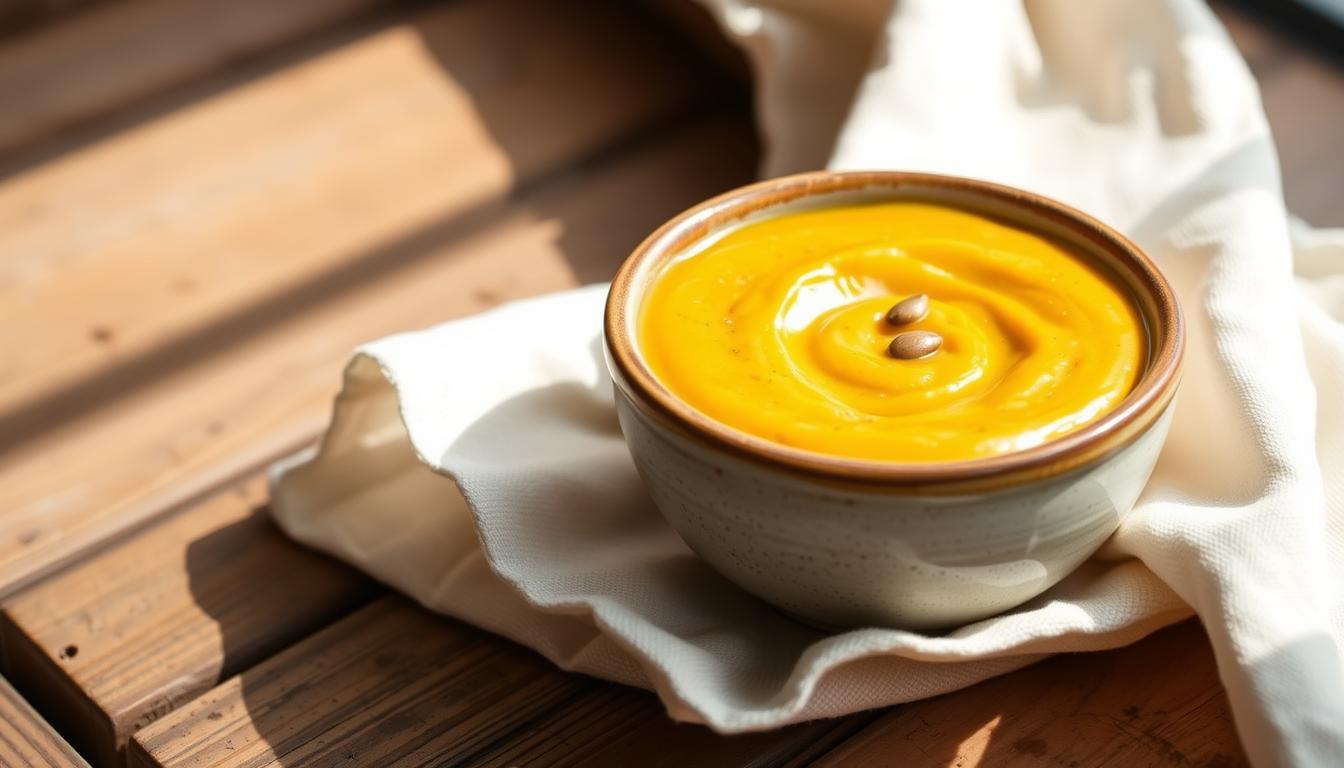Looking to add a spicy kick to your meals? Homemade Chinese Hot Mustard is the answer. This pungent and flavorful sauce is a key part of Chinese cuisine. Making it at home is surprisingly easy.
By making Homemade Chinese Hot Mustard yourself, you can adjust the spiciness and flavor. It’s not just for adding flavor to dishes. It’s also great for cooking and as a dip.
Key Takeaways
- Homemade Chinese Hot Mustard is easy to make and customize.
- It adds a spicy kick and flavor to various dishes.
- You can control the level of spiciness to suit your taste.
- It’s a versatile ingredient for cooking and as a dip.
- Homemade Chinese Hot Mustard is a fantastic complement to Chinese dishes.
The Fiery Appeal of Chinese Hot Mustard
Get ready to learn about the secret ingredient that makes Chinese food special – hot mustard. This spicy condiment is a key part of Chinese cooking. It adds a fiery kick and offers health benefits.
What Makes Chinese Hot Mustard Unique
Chinese hot mustard is unique because of its distinctive blend of mustard seeds and spices. It’s different from other mustards because of the special mustard seeds used. These seeds give it a special flavor and heat.
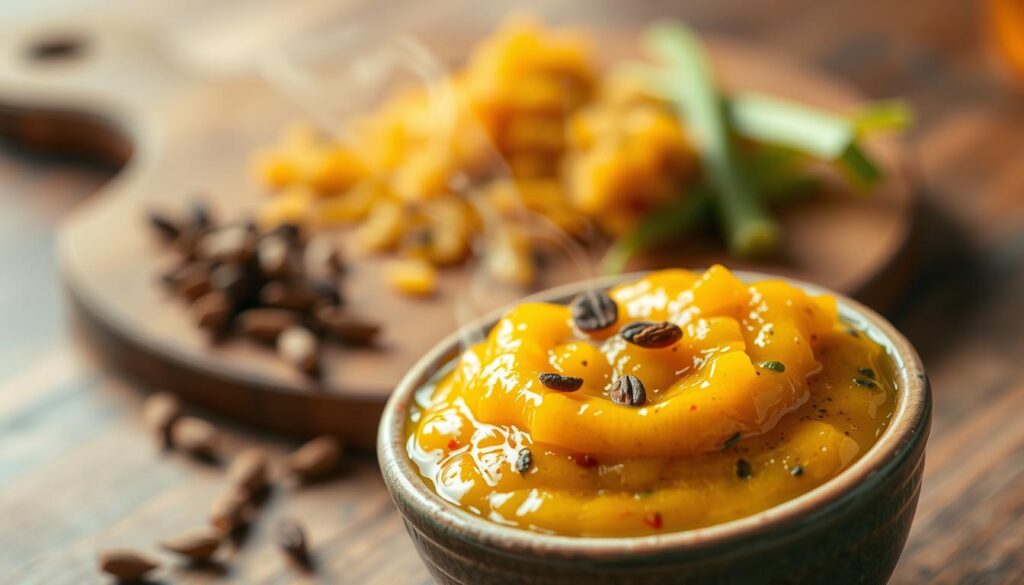
Health Benefits of Mustard
Mustard is more than just a tasty addition to your meals. It’s also full of nutrients. Here are some of its health benefits:
| Benefit | Description |
|---|---|
| Rich in Antioxidants | Mustard has antioxidants that protect cells from damage. |
| Anti-inflammatory Properties | The compounds in mustard can reduce inflammation. |
| Nutritional Value | Mustard is a good source of vitamins and minerals like vitamin C and potassium. |
The History and Cultural Significance
For many, Chinese hot mustard is more than a condiment. It’s a cultural symbol with deep roots. This pungent paste has been a staple in Chinese cuisine for centuries.
Origins in Chinese Cuisine
Chinese hot mustard originated in the Sichuan province. It’s known for its bold flavors and spicy dishes. Mustard has been used in Chinese cooking and medicine for ages.
Over time, hot mustard’s preparation evolved. It now has a distinctive flavor and heat.
Several factors helped in its development:
- The availability of mustard seeds
- Influence of regional culinary practices
- Trade and cultural exchange
Traditional Uses in Chinese Dining
In traditional Chinese dining, hot mustard is a condiment. It enhances the flavor of dishes like dumplings and noodle dishes. It’s also a dip for appetizers and snacks.
The spicy kick of Chinese hot mustard is believed to stimulate digestion. It adds depth to the dining experience.
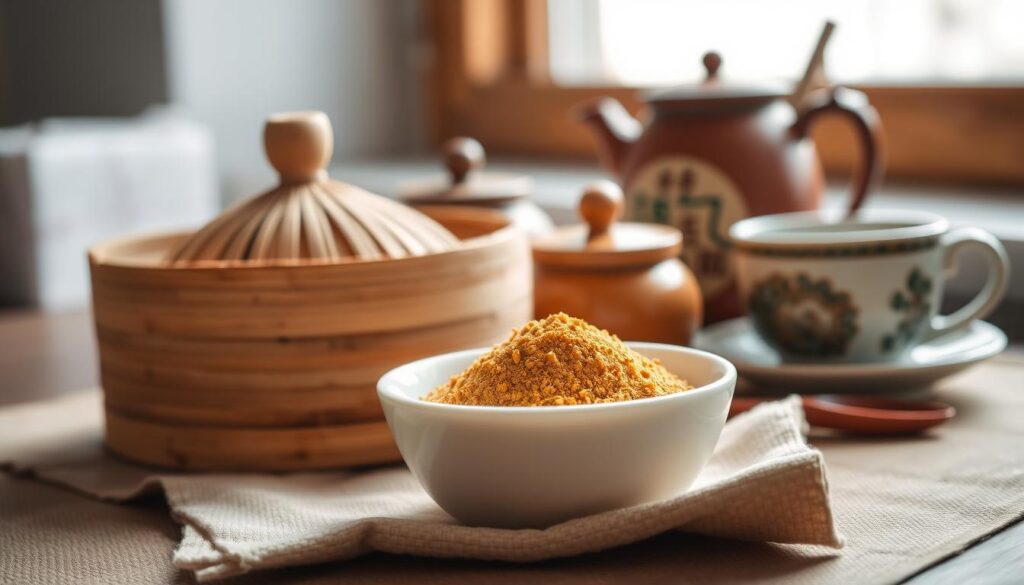
When making DIY hot mustard, you can adjust the spiciness and flavor. This makes it versatile for different dishes.
Homemade Chinese Hot Mustard vs. Store-Bought
Choosing between homemade and store-bought Chinese hot mustard depends on taste and convenience. Making it at home lets you control the ingredients and spice level. This way, you can tailor the flavor to your liking.
Flavor Comparison
Homemade Chinese hot mustard tastes fresher and more vibrant than store-bought. It’s made in small batches without preservatives, which can preserve flavor. You can also adjust the ingredients to your taste, making it perfect for you.
Store-bought mustard, however, has a consistent taste that some people prefer. It’s familiar and traditional. But, it might not have the depth and complexity of homemade mustard.
| Characteristics | Homemade | Store-Bought |
|---|---|---|
| Flavor Profile | Fresh, vibrant, customizable | Consistent, may contain preservatives |
| Ingredients | Controlled by the maker | May contain additives |
| Spiciness Level | Adjustable | Fixed |
Cost and Convenience Factors
Making Chinese hot mustard at home can be cost-effective over time. Ingredients are cheap and can be bought in bulk. But, it takes time to prepare.
Store-bought mustard is quick and easy to find. It saves time but can be expensive. You also can’t adjust the flavor to your liking.
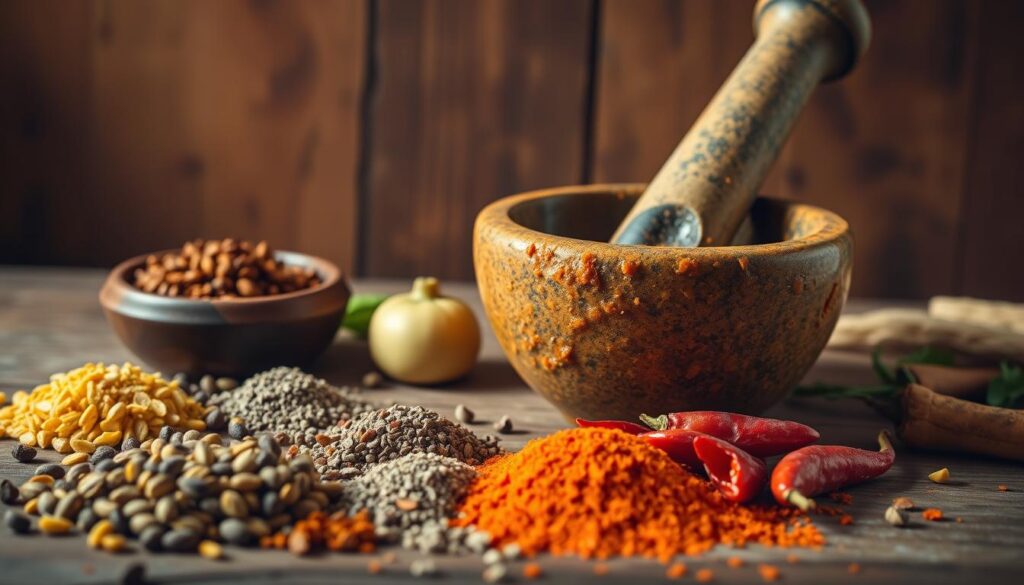
The Science Behind Mustard’s Heat
Learning about the science of mustard’s heat can make cooking more fun. It’s not just about taste; it’s about the chemical makeup of mustard.
Chemical Compounds at Work
The main compound causing mustard’s heat is allyl isothiocyanate. This happens when mustard seeds are ground and mixed with liquid. This mix triggers a reaction that creates the pungent and spicy taste we love.
Factors Affecting Spiciness
Several things can change how spicy your mustard is. These include the type of mustard seeds, the seed-to-liquid ratio, and how you prepare it. Trying different combinations lets you control the heat level. For example, using more volatile seeds can make it spicier. Adjusting the liquid can also tweak the spiciness and texture.
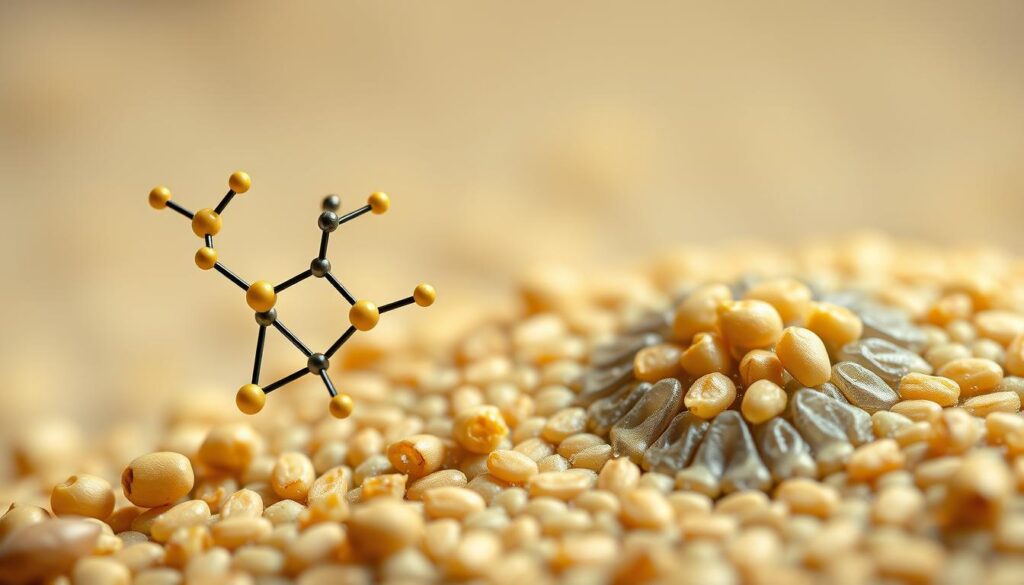
Essential Ingredients for Homemade Chinese Hot Mustard
To make Chinese hot mustard at home, you need just a few ingredients. The quality of these ingredients greatly impacts the taste and heat of your mustard.
Mustard Powder: The Foundation
Mustard powder is the main ingredient in Chinese hot mustard. It gives the condiment its unique flavor and heat.
Different Types of Mustard Powder
There are many types of mustard powder, like brown, white, and black. Brown mustard powder is often used for Chinese hot mustard because of its strong flavor.
Quality Indicators
When picking mustard powder, look for freshness and a bright color. Fresh mustard powder should smell pungent.
Additional Ingredients and Substitutions
You’ll also need water, vinegar, and salt. Some recipes might include turmeric or garlic powder for more flavor. You can change these ingredients to suit your taste or dietary needs.
Tools You’ll Need
To make homemade Chinese hot mustard, you’ll need a bowl, a spoon, and a container for storing it. A small grinder or mortar and pestle helps mix and get the right consistency.
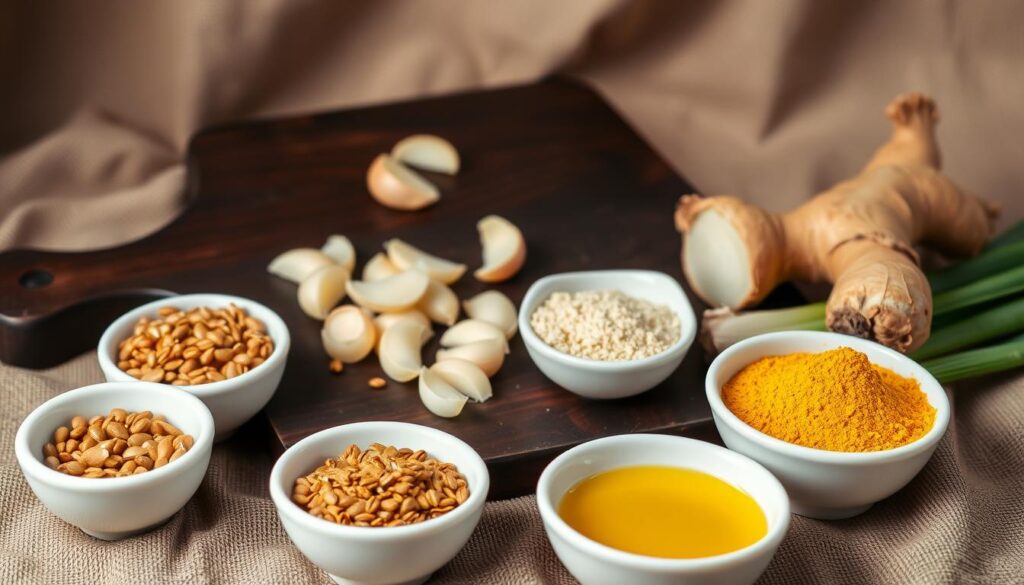
Step-by-Step Guide to Making Homemade Chinese Hot Mustard
Now, let’s make your own Chinese hot mustard at home. This homemade condiment tutorial will show you how to make a tasty DIY hot mustard.
Preparing Your Workspace
First, ensure that your workspace is clean and prepared. Get all the ingredients and tools you need. This will make the process fun and smooth.
Mixing the Base
Start by mixing 1 tablespoon of mustard powder with 2 tablespoons of cold water in a bowl. Stir until it’s smooth. You can change the ratio to get the right consistency.
Achieving the Perfect Consistency
To get the right consistency, add liquid slowly. Use vinegar, water, or both to thin it out. Add a little at a time, stirring well, until it’s just right.
Developing Flavor and Heat
To add flavor and heat, try adding grated ginger, garlic, or chili peppers. Mix different things to find what you like best. Some good things to add are:
- Grated ginger for a warm, spicy taste
- Minced garlic for a deep aroma
- Chili peppers or chili oil for lots of heat
By following these steps, you can make a delicious Chinese hot mustard that you’ll love.
Customizing Your Homemade Chinese Hot Mustard
Now that you’ve learned the basic recipe for homemade Chinese hot mustard, it’s time to get creative. You can make the mustard your own by adjusting the flavors to your liking.
Adjusting the Heat Level
One common thing to do is change the mustard’s heat level. If you like it milder, use fewer hot mustard seeds or add milder ingredients. For those who love spice, add more mustard seeds or try ghost peppers or hot sauce. Just remember to taste and adjust as you go.
Flavor Variations
You can also play with different flavors. Add rice vinegar for a tangy taste or honey for sweetness. Some people even add grated ginger or garlic for extra depth. The choices are endless, and you can pick flavors based on what you’re making.
Regional Chinese Mustard Styles
China has many different mustard styles, each from a different region. From Sichuan’s spicy mustard to the milder versions elsewhere, there’s a lot to explore. Learning about these regional styles can help you create a more authentic homemade Chinese hot mustard.
Serving Suggestions and Pairings
Now that you have homemade Chinese hot mustard, you can make many dishes better. It’s great with traditional Chinese food and can also spice up other dishes. This versatile condiment adds a kick to many foods.
Classic Chinese Dishes to Accompany
Homemade Chinese hot mustard is a key condiment in Chinese cooking. It goes well with Dumplings, Wontons, and Noodle dishes. It’s also good with roasted meats and vegetables. Here are some classic pairings:
- Siu Mai (Steamed Dumplings)
- Potstickers
- Cold Noodle Salad
Unexpected Uses for Hot Mustard
But there’s more to homemade hot mustard than just traditional dishes. Use it as a dip for fried foods, a marinade for grilled meats, or in salad dressings for a spicy twist. Here are some creative uses:
- As a topping for Baked Potatoes
- Mixed into Deviled Eggs
- As a spicy addition to Grilled Cheese Sandwiches
Creating a Chinese Dipping Sauce Spread
You can also mix your homemade Chinese hot mustard with other ingredients. Try adding soy sauce, vinegar, and chili oil to make different dipping sauces. Play with the amounts to find your favorite mix.
Storing Your Homemade Chinese Hot Mustard
Keeping your homemade Chinese hot mustard fresh is key. The right storage keeps its flavor and heat. It also makes it last longer.
Proper Containers and Conditions
For the best storage, use airtight glass or ceramic containers. Metal can react with the mustard, so it’s best to avoid it. Keep these containers in a cool, dark spot, like a pantry or cupboard. This keeps the mustard’s color and taste just right.
- Use airtight glass or ceramic containers.
- Avoid storing in metal containers.
- Keep containers in a cool, dark place.
Shelf Life and Preservation Tips
Stored right, your make your own hot mustard can last months. Always use clean tools when handling it to avoid contamination. You can also refrigerate it to keep it fresh longer.
- Use clean utensils to prevent contamination.
- Consider refrigerating to prolong freshness.
Troubleshooting Common Issues
Making homemade Chinese hot mustard is usually simple. But, some problems can pop up. These might mess with the taste, heat, or texture of your condiment.
Why Your Mustard Isn’t Hot Enough
If your homemade Chinese hot mustard isn’t spicy enough, it might be the mustard powder’s fault. Fresh, top-notch mustard powder is key for the right spice. Also, how much mustard powder you use compared to liquid matters a lot.
| Issue | Cause | Solution |
|---|---|---|
| Insufficient Heat | Old or low-quality mustard powder | Use fresh, high-quality mustard powder |
| Insufficient Heat | Incorrect ratio of mustard powder to liquid | Adjust the ratio to achieve desired heat |
Fixing Texture Problems
Texture problems, like it being too thin or too thick, are easy to fix. For a thicker mustard, add a bit of cornstarch or flour. If it’s too thick, a little more vinegar or water will help.
Conclusion
Now you know how easy and versatile homemade Chinese hot mustard is. Making your own lets you adjust the flavor and heat to your liking. This way, every dish you make is perfectly seasoned.
With your homemade Chinese hot mustard, you can spice up traditional dishes or try new recipes. You can even use it as a dip for your favorite snacks. The options are endless, and the taste will always impress.
So, why buy hot mustard from the store when you can make your own? Start playing with different ingredients to find your favorite mix. Homemade Chinese hot mustard will make all your dishes stand out.
FAQ
What is the main ingredient in homemade Chinese hot mustard?
Mustard powder is the main ingredient. It gives the condiment its flavor and heat.
Can I adjust the heat level of my homemade Chinese hot mustard?
Yes, you can. Change the amount of spicy ingredients like hot sauce or red pepper flakes to your liking.
How do I store homemade Chinese hot mustard to maintain its flavor and heat?
Keep it in an airtight container in the fridge. This helps keep the flavor and heat fresh for longer.
What are some common uses for homemade Chinese hot mustard?
It’s great as a dipping sauce for dumplings. You can also use it to marinate meats or add to noodle dishes and stir-fries.
Can I make homemade Chinese hot mustard without using mustard powder?
You can try using ground mustard seeds instead. But, the taste and texture might not be the same as traditional Chinese hot mustard.
How long does homemade Chinese hot mustard last?
Its shelf life depends on how you store it. If kept in the fridge, it can last several months.
What are some tips for customizing my homemade Chinese hot mustard recipe?
To customize, adjust the spiciness or try different flavors. You can also add regional Chinese mustard styles to your recipe.

